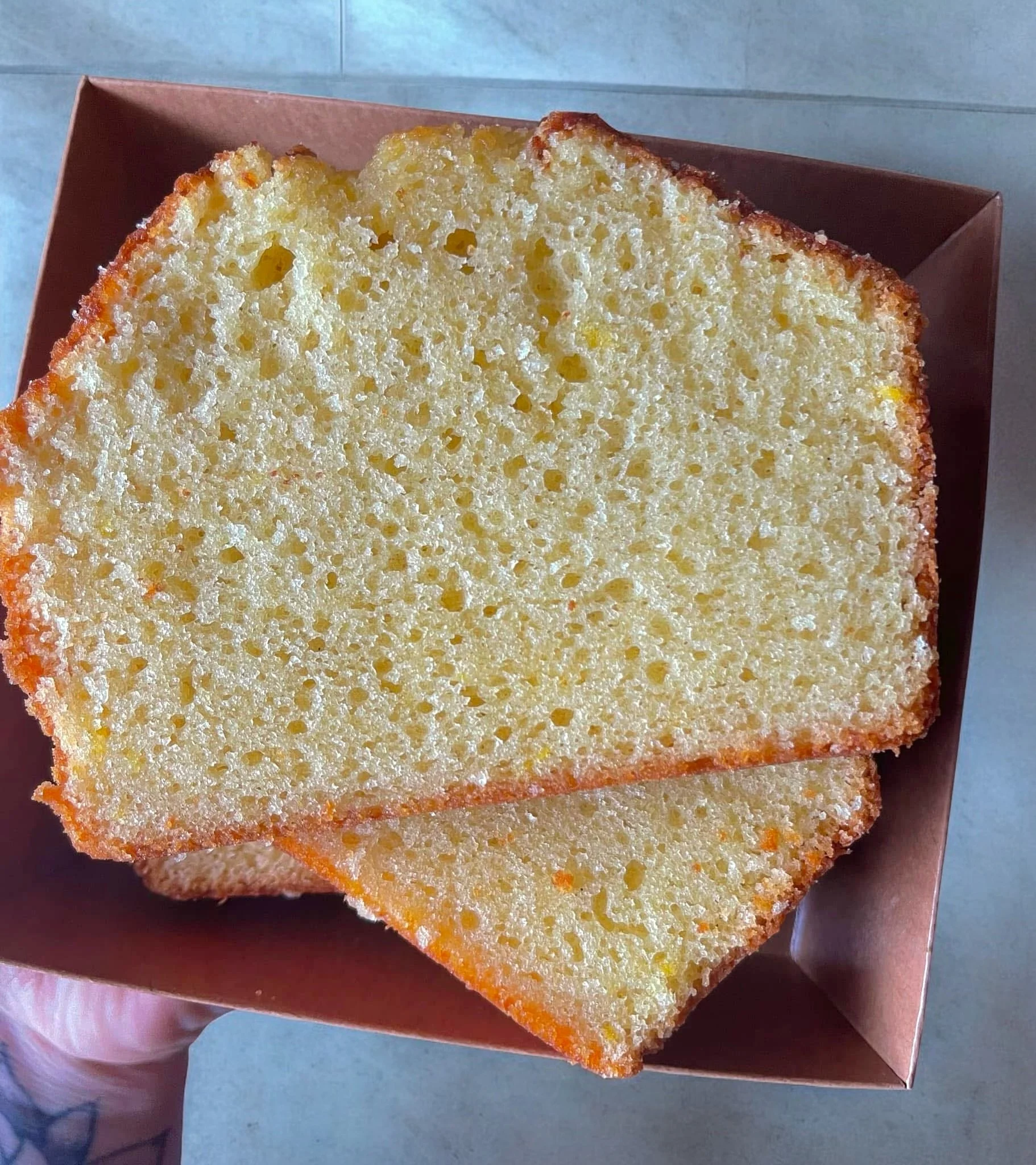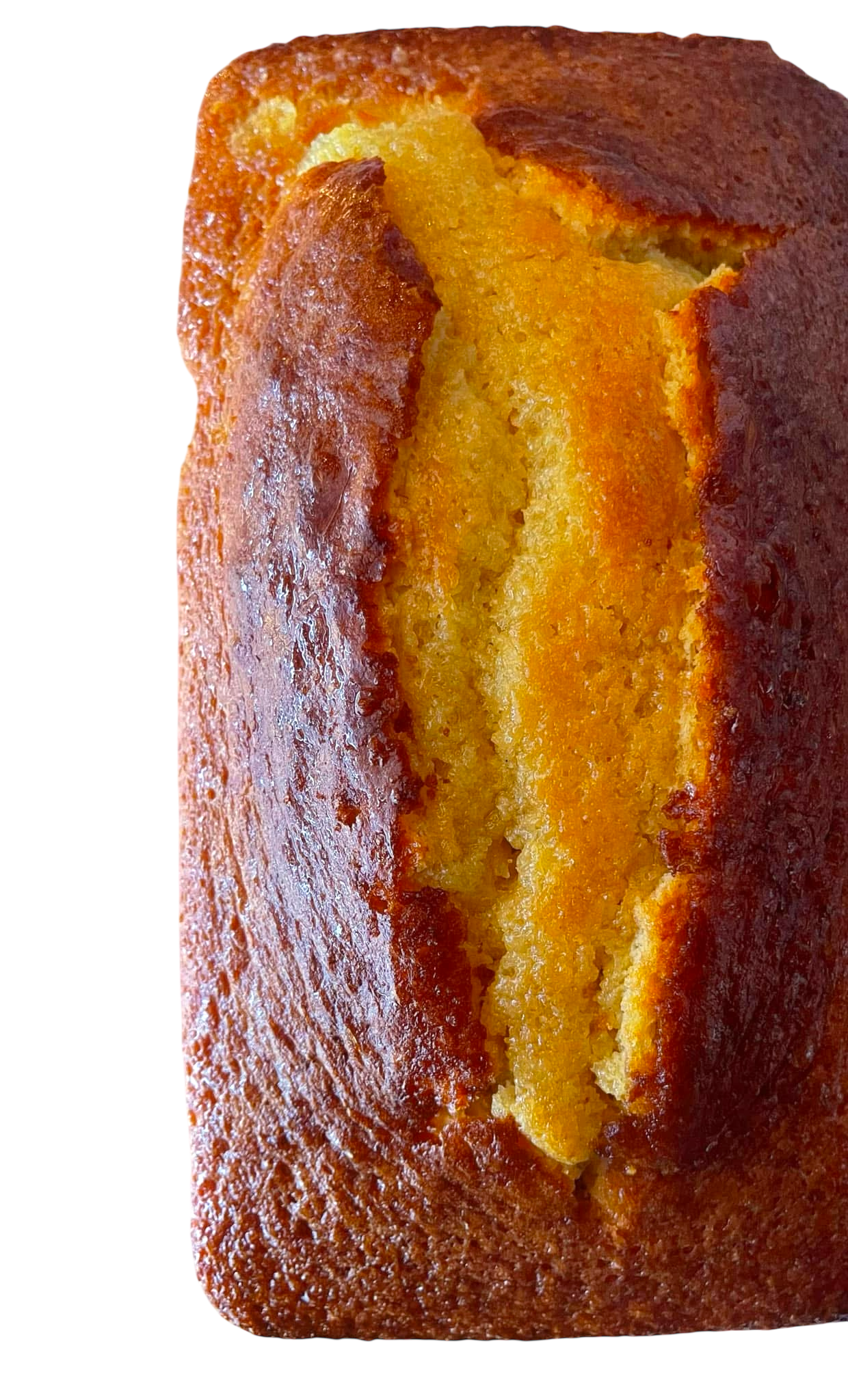Vanilla bean loaf cake
This Vanilla Bean Loaf Cake is a refined, French-inspired butter cake. This is not a dense American pound cake. With a soft, fine crumb and balanced richness, it’s modeled after the style of gâteaux de voyage, or "travel cakes" found in French patisseries. These cakes are known for their shelf-stability, gentle sweetness, and beautiful finish, often brushed with syrup for added moisture and shine.
Made with vanilla-infused cream, melted butter, and a touch of neutral oil, the batter bakes low and slow for a delicately domed, moist loaf. A warm vanilla rum syrup adds aromatic depth and that signature glossy top, making it a standout for gift-giving, bakery displays, or afternoon coffee service. It’s tender, elegant, and deeply aromatic.
Notes & Tips
For a Fine, Tender Crumb: Cake flour is key here. Its lower protein content helps create a more delicate structure, especially important since this recipe uses a high-fat ratio with butter, cream, and oil. Do not substitute with all-purpose unless absolutely necessary.
Emulsification Is Everything: The combination of eggs, yolks, and trimoline helps emulsify the batter and retain moisture. Adding the fats slowly (first the cream, then the melted butter and oil) prevents separation and ensures a smooth, glossy batter.
Professional Crack Technique: The crack on top isn’t just aesthetic. It controls expansion during baking. Piping a line of softened butter down the center creates a predictable split and gives that baker style visual finish.
Infused Cream for Depth: Infusing the cream with real vanilla bean brings a floral complexity you won’t get from extract alone. If you're using paste or extract only, still let your cream come to room temperature before adding to avoid shocking the batter. This vanilla loaf follows a French butter cake method where the batter relies on emulsification and gentle aeration rather than heavy leavening or creaming. Using room temperature ingredients is essential for achieving that smooth, pourable batter and fine, even crumb.
Syrup Absorption: Brushing the syrup while the cake is still warm allows it to fully soak in, giving a moist texture and sealing the surface to help extend shelf life.
Convection vs Conventional Ovens:
If using a convection oven, reduce the temperature to 325°F (163°C) for the first bake and 265°F (129°C) for the second. Convection bakes faster and browns more evenly, so check 5 minutes earlier for doneness. Conventional ovens retain more moisture, which works in your favor for this style of loaf.Shelf Life & Storage: This loaf keeps well for 2–3 days at room temperature if wrapped tightly. For longer storage, freeze without the syrup and apply it after thawing for a fresh-finished result.
Scaling Tip: This recipe doubles beautifully and can be baked in two loaf pans or in a single larger pan (adjust baking times accordingly).
Convection vs Conventional
This loaf was developed using a conventional oven, which offers a gentler, more stable bake. This is ideal for achieving a soft crumb and controlled rise. If you're using a convection oven (fan-forced), here’s how to adjust:
Convection Oven Adjustments
Reduce the temperature by 25°F (about 15°C)
So instead of 350°F, bake at 325°F, and when lowering to 285°F, reduce to 260°F.Start checking for doneness 5 minutes earlier
Convection bakes more efficiently, especially around the edges.
What to Expect in Convection:
More browning on the surface, especially on top and edges
Slightly faster bake time
Potentially less rise, especially if the crust sets before the interior has fully expanded. This can slightly reduce dome height or cause tighter crumb if the fan is too strong.
If you're using a convection oven and want to mimic the gentler effect of a conventional bake, you can turn off the fan if your model allows it or bake with a pan of hot water on the lower rack to reduce browning and slow down the heat exposure.
Vanilla Bean Loaf Cake
Ingredients
- 150g eggs, room temperature (3 large)
- 40g egg yolks, room temperature (2 large yolks)
- 200g granulated (or caster) sugar (1 cup)
- 10g trimoline or invert sugar (2 tsp) (substitute with 2 tsp corn syrup or honey)
- 10-12g vanilla paste (or extract) (2 tsp)
- Pinch of salt
- 175g cake flour, sifted (1 1/4 cups)
- 7g baking powder (1 1/2 tsp)
- 120g heavy cream, vanilla bean–infused (see below) (1/2 cup)
- 80g unsalted butter, melted and cooled to room temp (6 Tbsp)
- 35g neutral oil (canola or vegetable) (3 Tbsp)
- 120g water (1/2 cup)
- 100g granulated sugar (1/2 cup)
- 30g rum (2 Tbsp)
- 1 tsp vanilla bean paste or extract
Instructions
- Preheat the oven to 350°F (180°C). Line a 9x5-inch loaf pan with parchment paper.
- In a large bowl, combine the eggs, egg yolks, caster sugar, trimoline (or substitute), vanilla paste or extract, and a pinch of salt.
- Using a hand mixer or stand mixer fitted with the whisk attachment, beat on medium speed for 3–5 minutes until light and slightly thickened.
- In a separate bowl, sift together the cake flour and baking powder. With the mixer on low speed, gradually add the dry ingredients to the egg mixture until just combined. Be careful not to overmix.
- Still on low speed, slowly add the vanilla-infused cream. Then, stream in the melted butter and oil until the batter is smooth and emulsified.
- Pour the batter into the prepared pan and smooth the top with a spatula.
- Bake at 350°F (180°C) for 15 minutes, then reduce to 285°F (140°C) and continue baking for an additional 25–30 minutes, or until a skewer inserted in the center comes out clean.
- Let the cake rest in the pan for about 5 minutes, then lift it out and brush with the warm vanilla rum syrup (below).
- In a small saucepan, combine the water and sugar. Simmer over medium heat until the sugar is fully dissolved.
- Remove from heat and stir in the rum and vanilla extract. Let the syrup cool slightly.
- While the cake is still warm, brush generously over the top and sides to allow it to soak in.
- Gently warm 1/2 cup (120g) heavy cream with half a split vanilla bean in a small saucepan.
- Remove from heat and let steep for 5–10 minutes.
- Discard the pod and cool the cream to room temperature.


